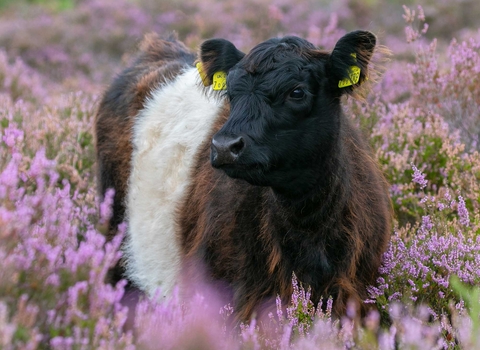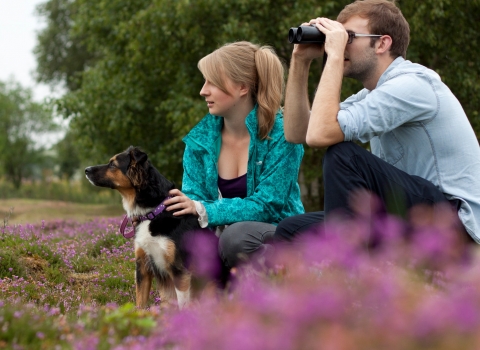Traditional, sensitive management
The landscapes of Surrey have been grazed for centuries and this has played a crucial role in shaping some of our most precious habitats. The Trust continues this practice to help preserve them today.
Why do we use conservation grazing?
The continuation or reintroduction of grazing is vital for the survival of habitats such as heathlands and chalk grassland. Many of the flora and fauna that exist within these landscapes now rely on this type of management to survive.
Livestock grazing is also beneficial as it has a less instantaneous impact than burning or cutting. The animals can also access areas which machinery can't. Much of Surrey’s remaining chalk grassland is on steep slopes, so sure footed animals are a more successful management tool than vehicles.
Grazing with cattle
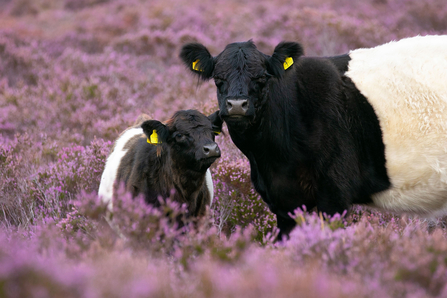
© Jon Hawkins
When you explore Surrey's nature reserves you may encounter our Belted Galloway cows - affectionately known as 'Belties.' These conservation heroes don't wear capes, but they are saving species one habitat at a time. Through their grazing and trampling, they craft a diverse tapestry of terrain, nurturing delicate wildflowers, pollinators, and endangered species, from Nightjars to Sand Lizards, to delicate wildflowers and orchid species.
This lack of uniformity can’t be achieved by machinery or humans. Cattle keep dominant grasses and thatch at bay through their grazing style; they pull and tear with their tongues and trample vegetation, forming different height structures as well as leaving hoof prints which turn into small puddles.
Grazing over 6,000 hectares of heathland and chalk grassland each year, our ‘Belties’ can be seen on reserves such as; Barossa, Thundry Meadows, Norbury Park, Chobham Common, Wisley Common, Elstead Common and Whitmoor Common.
Grazing with red deer
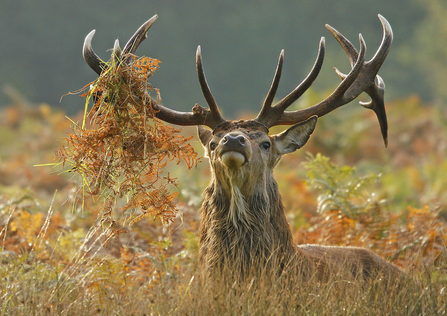
© Jon Hawkins
Pirbright Ranges is adjacent to a live firing range and owned by the MOD. It is also a wildlife rich heathland habitat.
Access is heavily restricted for safety reasons, which makes it challenging to manage the habitat with conventional techniques. The solution - use red deer, a native species that is ideally suited to the heathland and woodland habitats found on the Ranges.
Although once widespread throughout Surrey, Red Deer in the county are now mostly restricted to deer parks and a few small, wild herds.
The deer are doing a magnificent job in managing the amounts of pine, birch and gorse on the heath as well as creating a diverse structure in the regenerating heather. As a result, nightjar, woodlark and Dartford warbler populations are on the increase.
The Trust maintains the herd at around 200 animals and uses special vehicles and camera traps to monitor their welfare.
July 22 Wildfire
In July 2022 Pirbright Ranges suffered an extensive wildfire covering some 650ha of the reserve. It is expected to take over a decade for the site to recover to its former condition.
Grazing with sheep
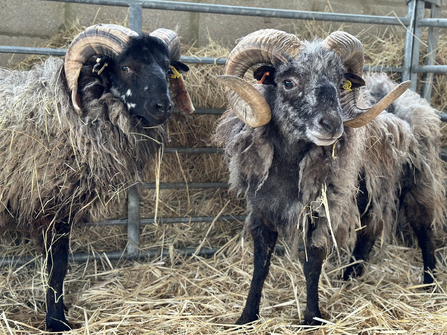
© Marcus Wehrle - Surrey Wildlife Trust
A current focus for our grazing team is to develop a new crossbreed of sheep. By combining the characteristics of Boreray and Wiltshire Horn sheep, we are establishing a breed that embodies wool-shedding traits, a gentle temperament, and effective grazing and browsing behaviours.
Boreray originate from the Outer Hebrides, are small in size with wild deer like behaviour. They are excellent browsers, are very hardy and can shed their wool. Wiltshire Horn are a native, large traditional breed that are very docile and also wool-shedding.
The ability of our sheep to naturally shed wool will lessen the need for chemical intervention by reducing the risk of fly strike, while their shorter fleece prevents unwanted entanglements. Their light footprint also minimises any environmental impact in wet conditions.
Our first crossbred lambs arrived in 2023 and we are now starting to see the desired traits in successive generations.
Why do we graze with sheep?
Our sheep support chalk grasslands and wildflower meadows of our east and central Surrey reserves, curbing the growth of the coarse grasses and thatch which threaten to dominate these habitats if left uncut. The sheep returned to Quarry Hangers, Larks Rise and Pewley Meadows for the second year in 2024 and we had our own sheep on Hill Park for the first time.
The adept browsing of sheep also aids in managing scrub and bramble, further enhancing habitat health. By creating open spaces for less dominant species and regulating nutrient levels, they will help to maintain the delicate balance of the ecosystem.
Nofence grazing
On an increasing number of sites, our Belted Galloway cattle are no longer kept in fenced compartments. Instead, the cattle are kept to designated grazing areas using solar-powered ‘Nofence’ GPS collars, which emit a harmless electrical pulse to any individual that strays beyond a prescribed zone.
The cattle soon learn not to wander and are not stressed by this technique. The herd's location is monitored remotely using software, and in the rare event that an animal does stray, staff are alerted automatically via text and can step in quickly to escort the wanderer to safety. This is far safer than using electric fencing, as we are immediately made aware of any escapees.
Why do we use Nofence grazing?
Nofence grazing removes the need for physical fences, thus reducing the costs of their installation and maintenance across our sites, as well as limiting the physical impact on the landscape. It also allows more targeted grazing, helps us track the animals across the sites we manage, and ensures their welfare.
NoFence grazing has been used successfully across the country and the Trust have used it for the last two years on two of our sites without issue.
Viewing a herd's location on a site
Members of the public can check the location of cattle on a site with Nofence grazing by scanning a QR code or following a link displayed on reserve notice boards, which also have a printed map showing the current grazing area.
Nofence grazing site map
Select a cattle icon to view the site name.
Grazing contact
For queries regarding grazing, please call Surrey Wildlife Trust on 01483 910087 or email countryside@surreywt.org.uk
In the event of a livestock emergency ONLY, please call 07817 769672. The phone is manned by a member of the grazing team at all times.

Equipment to assist with management of our conservation grazing scheme is part funded by the European Agricultural Fund for Rural Development

